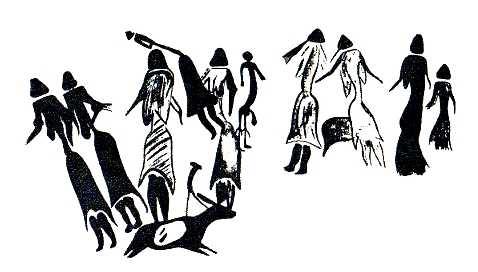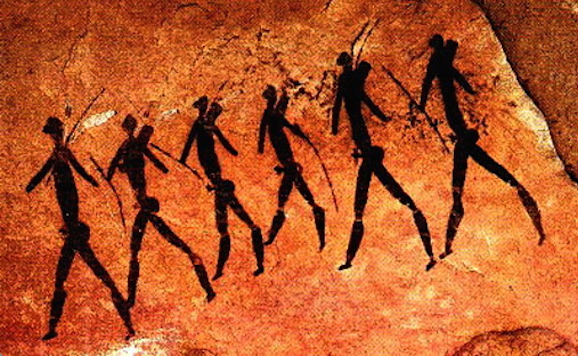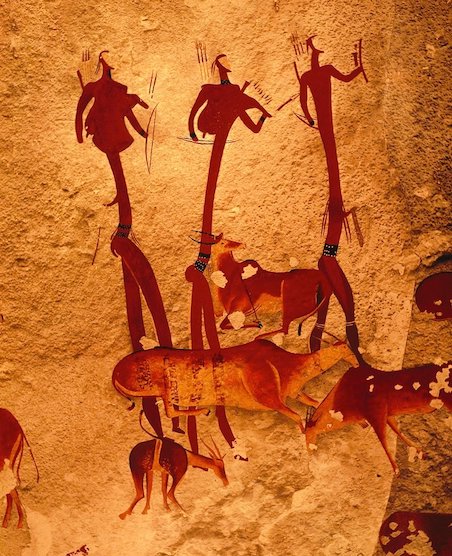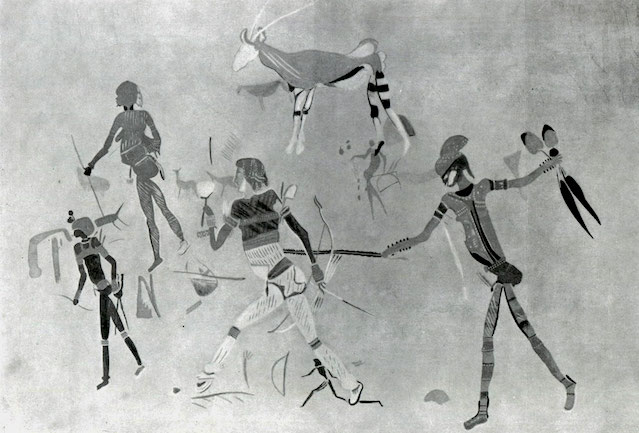Museum of the Origins of Man
ANTHROPOMORPHIC AND ZOOMORPHIC PAINTINGS ON ROCKY WALL IN THE POST-PALEOLITHIC
 Fig. F48) Painting in a helter under rock (detail).
Fig. F48) Painting in a helter under rock (detail).
Possibly ritualistic dance of nine women around a man, and animals.
Dating: approx. 8500 years ago.
Material culture: Mesolithic.
Size: very small.
Location: El Cogul or Roca de los Moros, Lerida, Catalonia (Spain). UNESCO, World Heritage Site.
Location: Museum of Archaeology of Catalonia, Barcelona (drawing based on H. Breuil 's trace, taken from originals defaced in storage).
 32A5) Procession of hunters painted in a shelter under rock.
32A5) Procession of hunters painted in a shelter under rock.
This type of painting begins in the Mesolithic and continues among the Bushmen in South Africa to the present day.
Location: Drakensberg Mountains, South Africa.
In South Africa, probably, by Bushmen with different cultural traditions, there are zoomorphic rock graffiti (see Fig. 33A6).
 Fig. 32A6) "Giraffes" men and animals in South Africa.
Fig. 32A6) "Giraffes" men and animals in South Africa.
This painting is extremely interesting for the "elongated vertical style" of men. The animals were probably painted in later times, and have a "realistic style". Also curious the antelope in the foreground, painted in perspective, in fact, you can see first the two hind legs, and then inside the two front legs; generally, in prehistoric painting of Paleolithic tradition, the animals are painted in side view.
Bushmen 's art.
Location: Ukhahlamba-Drakensberg Park, South Africa.
Dating: this work should have two datings, one for men, and one for animals, as the paintings are superimposed.
 Fig. 32A7) Men and animals (drawing of the disfigured painting).
Fig. 32A7) Men and animals (drawing of the disfigured painting).
It is called "The White Man". from the image of the shaman with white legs and arms. It could be a ritual dance or a hunting scene.
Size: the largest figure, 3.95 cm high; 29 cm wide.
Location: Brandberg Massif, Namibia, South Africa.
Dating: probably 2000 years ago.
Bushmen's art.
This work is a superimposition of larger figures to smaller ones, therefore it should have two datings like Fig. 32A6.
Overlaps of paintings and engravings are also found in the Upper Paleolithic in Europe in the caves that have been a place of worship for the longest time. It is likely that when the rite was to be performed, if there were not available walls, it was painted on previous pictures.
(from H. Breuil, 1948).
NEXT
Index
HOME PAGE
Copyright©1999-2020 by Museum of the Origins of Man, all rights reserved.




